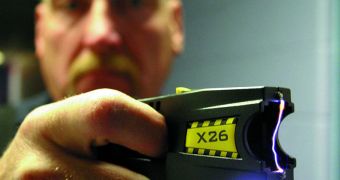The Taser stun gun or electroshock weapon is an incapacitant weapon, used to administer an electric shock to a hostile person or a criminal suspect, that will disrupt the superficial muscles' functions, triggering them to contract irregularly regardless of the signals sent by the brain.
The electroshock weapons produce a temporary high voltage, low current electrical discharge, to override the signals sent by the brain. The person who is being shocked experiences great pain and temporarily paralysis during the period of time the electrical current is being applied. To overcome the human skin electrical resistance, the device must produce high voltage, however the current applied must be relatively low and carefully restricted under certain limits due to potential severe injury.
The models currently produced have a voltage range around 50 kV up to 1000 kV, but most of them have voltages that don't exceed 300 kV. Persons getting shocked with a Taser gun can experience voltages as high as 100 kV for a couple of seconds, but only a second of 1000 kV. The current created is in the range of 2.1 to 3.6 mA, everything over 10 mA at frequencies of 60Hz being considered potentially lethal, even though not all of the Tasers produce currents at 60 Hz.
The U.S. army design of the Taser gun, M-26 can produce a pulsing current that can peak 18 amperes, for about 10 microseconds, by using AA standard batteries.
The internal circuits of the Taser guns take power from one or more standard 9 volts batteries and convert it from DC to AC current, after which the AC current is fed into a voltage multiplier, based on the principle of the oscillator resonant circuit and step up transformer, that converts it back to DC current but at higher tensions. Depending on the models, they can also produce alternating high-voltage discharges.
The discharge is applied to the subject, when both of the metallic rods, which conduct the current, touch the person. The metal rods of the Taser itself are insulated one from another and spaced at about 2.6 centimeters apart.
Some Tasers are designed in the form of pistol weapons, or batons which require close contact for them to be effective, while others fire metal darts which are connected to the Taser through thin strong metal wires that conduct the electrical current, so the hostile person can be stopped from relatively large distance, before he gets the chance of approaching too much.
Though it is designed as a non-lethal weapon, there have been cases when people have died as a result of getting shocked with Taser guns. It is currently widely used by police departments all over the world to stop violent criminal suspects. Nevertheless sometimes harmless people get shocked.
Currently Taser is being investigated by IEEE Spectrum to reveal what actually happens when a person gets shocked, especially those with cardiac diseases and what it takes for a Taser shot to be lethal.
The name Taser is the acronym for Thomas A. Swift's Electric Rifle, given by Jack Cover who designed it in 1969 and named it for the young inventor Thomas Swift.

 14 DAY TRIAL //
14 DAY TRIAL //